Hello everyone,
Today i would like to explain about Respiratory system , Hope you will have a feel that you learned something today .
So lets get started ,
Introduction :-
Respiration is a catabolic process of release of energy mostly by the Oxidation of foods.Oxygen obtained from the surrounding medium is utilized in the Production of Metabolic water, an end product of the 'Burning of calories'.
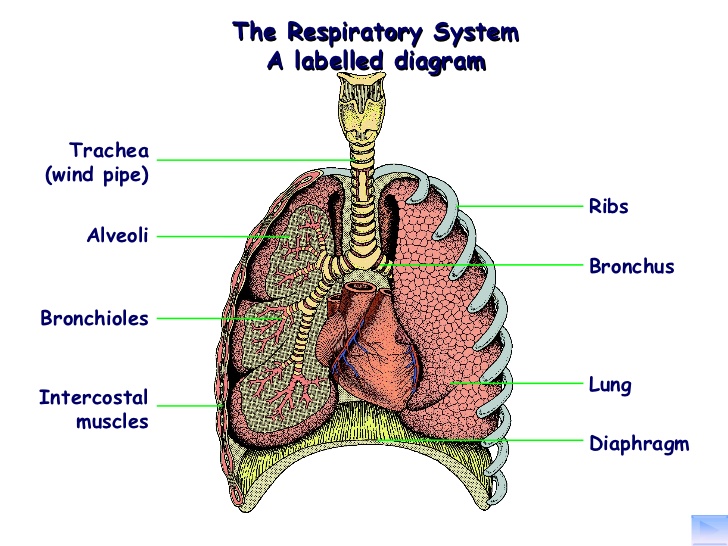
- Birds have a developed technique of continuous exchange of gases even expiration with help of a unique feature-The presence of 'Air sacs' and 'Parabronchi'.
- At the height of about 6000 m the PO2 becomes almost half of what it is at the mean sea level.Hence the 'Mountain sickness' in people ascending maintains.
The "Rib cage" and the "Diaphragm" helps mammals breach in air more effectively.Homeostasis of O2 and CO2 are under the control of the respiratory center.Inhalation and exhalation are under the control of the Medulla Oblongata.There is a pneumatic center in the pons and it controls the rate & depth of breathing.
Many authors describe the process of Gaseous exchange as "External Respiration" or "Ventilation" because it emphasizes that the entry of oxygen and the exit of CO2 happen at places other than the energy releasing sites.
- More accurately the process leading to & including the chemical breakdown of food materials to provide energy for life is called "Respiration".
- As the Chemical breakdown of the nutrients occurs inside the living cells of every organism , it is called "Internal Respiration" or "Cellular Respiration".
> Anaerobic Respiration :
Anaerobic respiration is the incomplete breakdown of organic molecules with less yield of energy,it takes place in the absence of oxygen in organisms such as yeast , Bacteria,muscles.
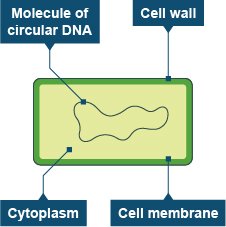
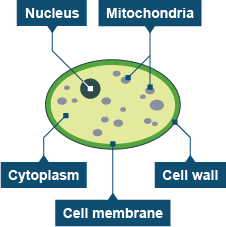

> Aerobic Respiration :
Aerobic respiration yields more energy(Gradually) due to complete breakdown of organic molecules , utilizing oxygen.
Respiratory Organs :-
Protozoans and lower invertebrates such as the Sponges , Cnidarians, flatworms etc., exchange with by simple diffusion over their entire body surface. Earthworms use their moist body wall , insects have a network of tubes (Trachea system) to transport atmospheric air with in the body.
- Spiders & Scorpions have book lungs for aerial respiration special vascular structures called gills are used by most of the Aquatic arthropods & Mollusus , whereas vascular bags called lungs are used by the terrestrial forms for the exchange of gases.
- Among vertebrates fishes & larval of amphibians use gills , where as the reptiles , birds & mammals respire through lungs .
- Amphibians like Frogs respire through their moist skin & lungs also mammals have a well developed respiratory system.
Human Respiratory system :-
Respiratory of man includes the following :-
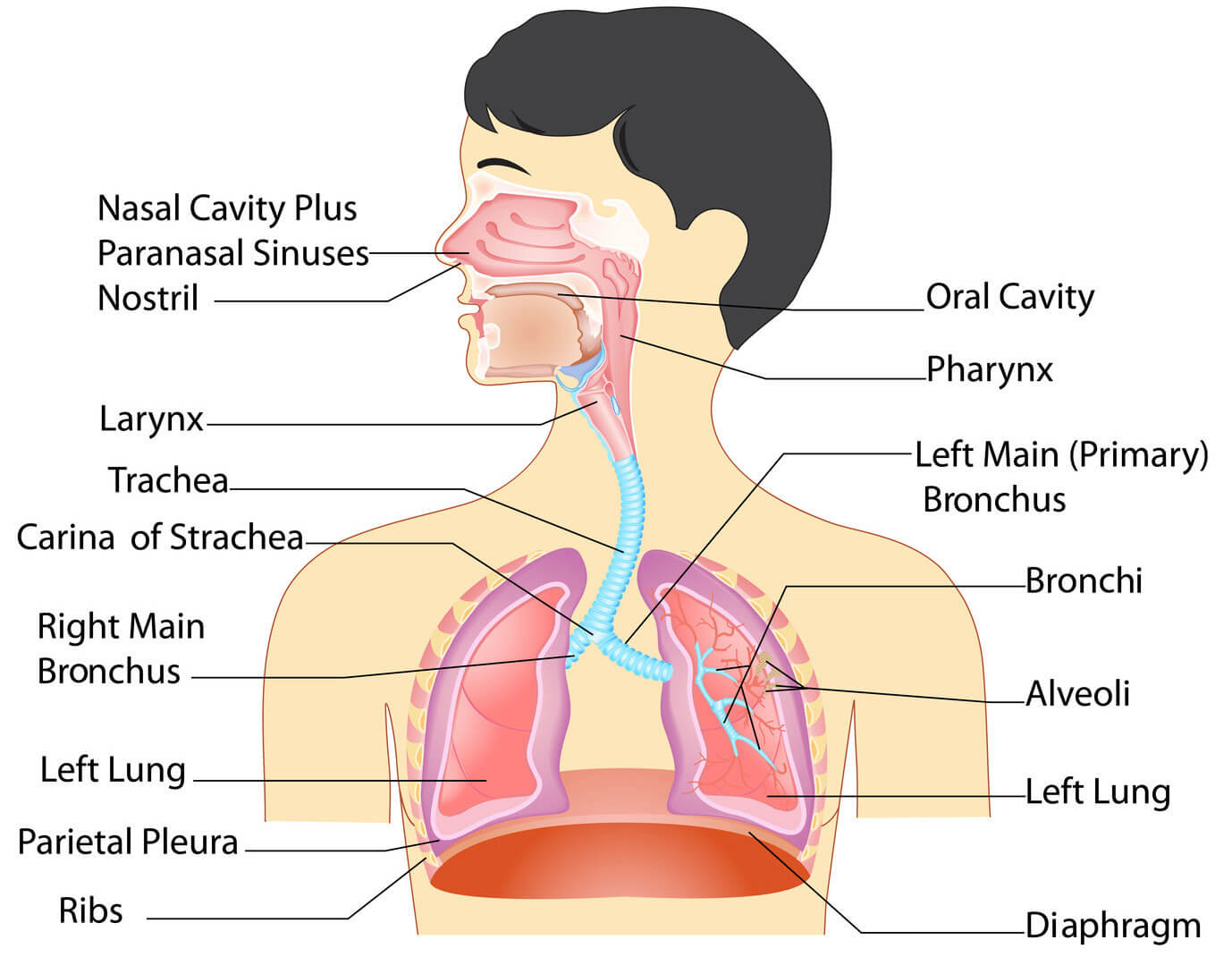
> External Nostrils :
A pair of external nostrils opens out above the upper lip.They lead into nasal chamber.
> Nasal chamber :
They lie above the Palats & are separated from each other by a Nasal Septum.Each nasal chamber can be differentiated into three parts namely :
- Vestibule part- which has hair & sebaceous glands to prevent the enter of dust particles.
- Respiratory part - which is involved in the conditioning the temp of inhaled air , it has three thin, twisted bony plates called Turbinal.
- Olfactory part - Which is lined by an olfactory epithelium.
> Naso-Pharynx :
Nasal chambers lead into Nasopharnyx through a pair of internal nostrils ; located above the soft palate.Nasopharnyx is the upper portion of the pharnyx.
>Larynx :
Larnyx is a cartilaginous box which helps in sound production ,hence called the voice box wall the larnyx is supported by nine cartilage.
- Thyroid,cricoid & epiglottis are the unpaired cartilages, where as corniculate cartilages , arytenoids & cunei form cartilages are the paired cartilages.
- Epiglottis is a thin leaf like elastic cartilaginous flop attached to the thyroid cartilage to prevent the entry of food into the larnyx through the glottis.
The yellow elastic fibers which connect the thyroid & arytenoid cartilages are called vocal cords.The opening between the tree vocal cords & the Arytenoid cartilages is called Rima glottidis .
- The mid ventral part of the Thyroid cartilage forms the laryngeal prominence called Adam's apple.
- In males , the vocal cords are thicker , longer & produce low pitch voice where as in women & children the vocal cords are usually short & produce high pitch voice.
> Trachea :
Trachea the wind pipe is a straight tube extending up to the mid-thoracic cavity.The wall of trachea is supported by c-shaped rings of hyaline cartilage .These rings are incomplete dorsally & keep the trachea always open preventing collapse.
Internally the trachea is lined by Pseudostratified ciliated epithelium.
> Bronchi and Bronchioles :
On entering the mid thoracic cavity , trachea divides at the level of the fifth thoracic vertebra into right & left primary bronchi.
- Each primary bronchus enters the corresponding lungs & divides into secondary bronchi that further divides into tertiary bronchi .
- Each tertiary branches divides & re-divides to form primary , secondary , tertiary , terminal & respiratory bronchioles sequentially.
- Each respiratory bronchiole terminates in a cluster of alveolar ducts which end in alveolar sacs.
- The branchingnetwork of trachea , bronchi & bronchiles constitute the pulmonary tree.
> Lungs :
Lungs occupy the greater part of the thoracic cavity.lungs are covered by a double layered "Pleura" with pleural fluid between them. It reduces friction on the lung surface.The outer pleural membrane is in close contact with the thoracic lining whereas the inner plueral membrane is in contact with lungs surface .
- The part starting with external nostrils up to the terminal bronchioles constitute the conducting part whereas the aveoli & their ducts form the respiratory part of the respiratory system.
- The conducting part transports the atm air to the alveoli, clears it from foreign partilcles , humidifies & also brings the inhaled air to the body temp.Exchange part us the size of actual difficulties of O2 & CO2 between blood & atm air.
- The lungs are situated in the thoracic chamber which is anatomically an air tight chamber. It is formed dorsally by the vertebral column , ventrally the sternum , laterally by ribs & on the lower side by the Dome shaped diaphragm .
- The anatomical setup of lungs in the thorax is such that any change in the volume of thoracic cavity will be reflected in the lung cavity .Such an arrangement is essential for breathing as the pulmonary volume cannot be directly altered .
Source : Youtube
Mechanism of Breathing :
Breathing is a means of maximising the process of gaseous exchange.The movements of air into & out of the lungs is carried out by creating a pressure gradient between the lungs & the atmosphere .Breathing involves two stages such as Inspiration & expiration.
- Inspiration can occur if the pressure with the lungs is less than the atm pressure i.e., there is a negative pressure in the lungs with respect to atmospheric pressure .
- The Muscular diaphragm & a specialized set of muscles the external & internal inter-coastal muscles help in generating such gradients .
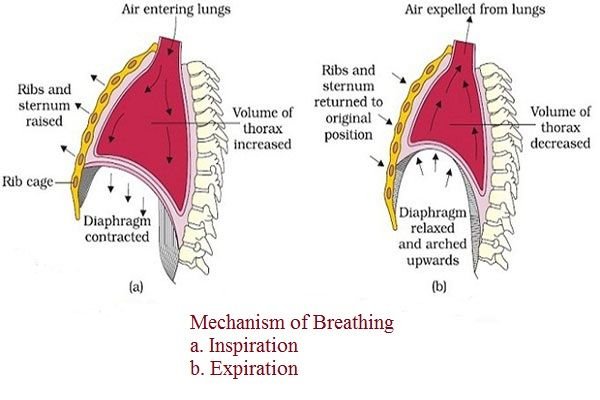
source
Inspiration :
It is an active pressure as it takes place by the contraction of the muscles of the diaphragm & the external inter-coastal muscles, which extend in between the ribs .The contraction of diaphragm increases the volume of the thoracic chamber in the antero-posterior axis . The contraction of external inter-coastal muscles lifts up the ribs & sternum causing an increase in the volume of the thoracic chamber in the dorsoventral axis .
The overall increase in the thoracic volume causes a similar increase in the pulmonary volume.As increase in the pulmonary volume decreases the intra pulmonary pressure to less than that of the atmospheric which forces the air from the outside to move into lungs i.e., Inspiration.
Expiration :
It is a passive process relaxation of the diaphragm & the external inter-coastal muscles returns the diaphragm & sternum to their normal positions & reduces the thoracic volume & thereby the pulmonary volume .This leads to an increase in the Intra-pulmonary volume pressure to slightly above that of the atm pressure causing the expulsion of air from the lungs i.e., Expiration.
- We have the ability to increase the strength of inspiration & expiration with the help of additional muscles in the abdomen.On an average a healthy human breathes 12-16 times/minute.
- The volume of the air involved in breathing movements , can be estimated by using a spirometer which helps in clinical assesement of the pulmonary functions .
Source : Youtube
References :
- Mechanism of breathing
- Respiratory system
- Respiratory organs
- Medulla oblongata
- Nasal cavity
- Tracheal Breathing
- Thyroid cartilage

gerçek anlamda güzel bir yazı olmuş elinize sağlık
Downvoting a post can decrease pending rewards and make it less visible. Common reasons:
Submit
Thanks :) i joined
Downvoting a post can decrease pending rewards and make it less visible. Common reasons:
Submit
You got a 5.91% upvote from @postpromoter courtesy of @saimegh!
Want to promote your posts too? Check out the Steem Bot Tracker website for more info. If you would like to support the development of @postpromoter and the bot tracker please vote for @yabapmatt for witness!
Downvoting a post can decrease pending rewards and make it less visible. Common reasons:
Submit
This post has received gratitude of 0.72 % from @appreciator thanks to: @saimegh.
Downvoting a post can decrease pending rewards and make it less visible. Common reasons:
Submit
This can be tagged with @air-clinic also. Please feel free to join
Downvoting a post can decrease pending rewards and make it less visible. Common reasons:
Submit
Thanks :) i joined
Downvoting a post can decrease pending rewards and make it less visible. Common reasons:
Submit
so much have learnt thanks
Downvoting a post can decrease pending rewards and make it less visible. Common reasons:
Submit